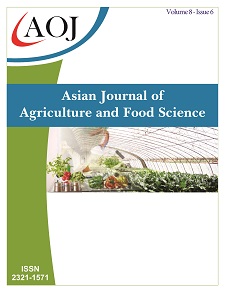Partial Characterization of Glucoamylase Crude Enzyme Produced by Aspergillus and Rhizopus Strains
DOI:
https://doi.org/10.24203/ajafs.v8i6.5254Keywords:
Characterization, Glucoamylase, Aspegellus & Rhizopus isolatesAbstract
Glucoamylase is widely used in the food industry to produce high glucose syrup, and also in fermentation processes for production of beer and ethanol. In this work glucoamylase enzyme produced by six fungal strains were previously isolated from different Sudanese soils, crop seeds, rotten fruits and pieces of moistened bread designated as Aspergillus awamori (A1and A7), A. niger (A10) , A. tamari (Aw), A. terrus (At) and Rhizous oryzae (R3) in a liquid culture was evaluated and characterized. The maximum temperature of glucoamylase activity are found to be in the range of 60-70˚C and at pH value of 5.0-6.0 and the activity of all enzymes from all isolates increased with increase of the concentration of soluble starch. Also the activity of the enzyme from all isolates under study increase with increase of time reaction.
References
• Abdalwahab, S. A., Ibrahim, S. A. and Dawood, E. S. (2012). Culture condition forthe production of glucoamylase enzyme by different isolates of Aspergillus spp. International Food Research Journal 19 (3): 1261-1266
• Bernfeld, P.(1951). Enzyme of starch degradation and synthesis. Advan. Enzymol., Vol. 12. pp. 382-428, F.F. Nord ed., Interscience Publishers, Inc. New York.
• Bradford, M. M. 1976. A rapid and sensitive method for the quantitation of microgram quantities of proteinutilizing the principle of protein dye-binding. Analytical Biochemistry 72: 248-254.
• Coral G, Colak O (2000).The isolation and characterization of glucoamylase enzyme of Aspergillus niger natural isolate-Turk. J. Biol., 24: 601-609.
• Deb, P. ; Talukdar, S.A.; Mohsina,K.; Sarker P. K. and Saye, S. A. (2013). Production and partial characterization of extracellular amylase enzyme from Bacillus amyloliquefaciens P-00. SpringerPlus 2013, 2:154
• Gupta R, Gigras P, Mohapatra H, Goswami VK, Chauhan B (2003) Microbial α-amylases: a biotechnological prospective. Process Biochem 38:1599–1616
• Mertens, J.A.; Skory, C.D. (2006). Isolation and characterization of a second glucoamylase gene without a starch binding domain from Rhizopus oryzae. Enzy. Microbia. Technol., 40, 874-880.
• Muhammad, J. A. , Muhammad, G., N. M.,Nyla, J., Saqib, H., Hadri, M. I., Zahid A. andDawood, A. 2011. Hyper production of glucoamylase by
• Aspergillus niger through the process of chemical mutagenesis. International Journal of the Physical Sciences Vol. 6(26), pp. 6179-6190.
• Norouzian, D.; Akbarzadeh, A.; Scharer, J.M.; Young, M.M. Fungal glucoamylases. Biotechnol. Adv. 2006, 24, 80–85.
• Pestana, F. and Castillo, J. (1985). Glucoamylase production by Aspergillus awamori on rice flour medium and partial characterization of the enzyme. MIRCEN Journal of Microbiology and Biotechenology 1, 225-237.
• Zambare, V. Solid state fermentation of Aspergillus. oryzae for glucoamylase production on agro residues. Int. J. Life Sci. 2010, 4, 16–25.
Downloads
Published
Issue
Section
License
Copyright (c) 2020 Suhair Ahmed Abdelwahab

This work is licensed under a Creative Commons Attribution-NonCommercial 4.0 International License.
Copyright © The Author(s). This article is published under the Creative Commons Attribution License (CC BY 4.0), which permits unrestricted use, distribution, and reproduction in any medium, provided the original work is properly cited.


